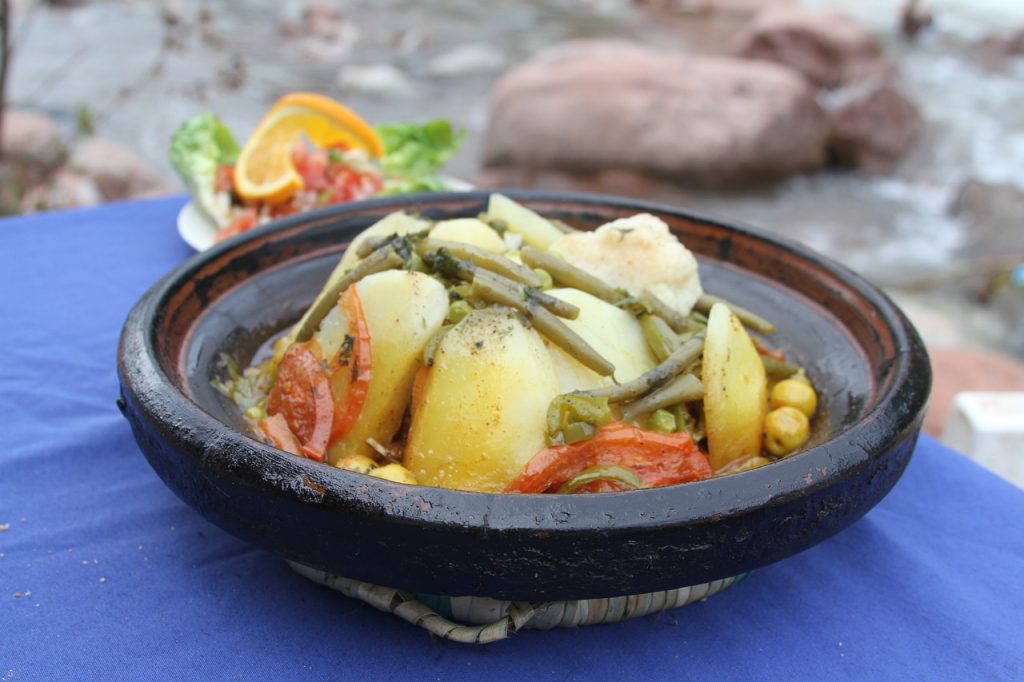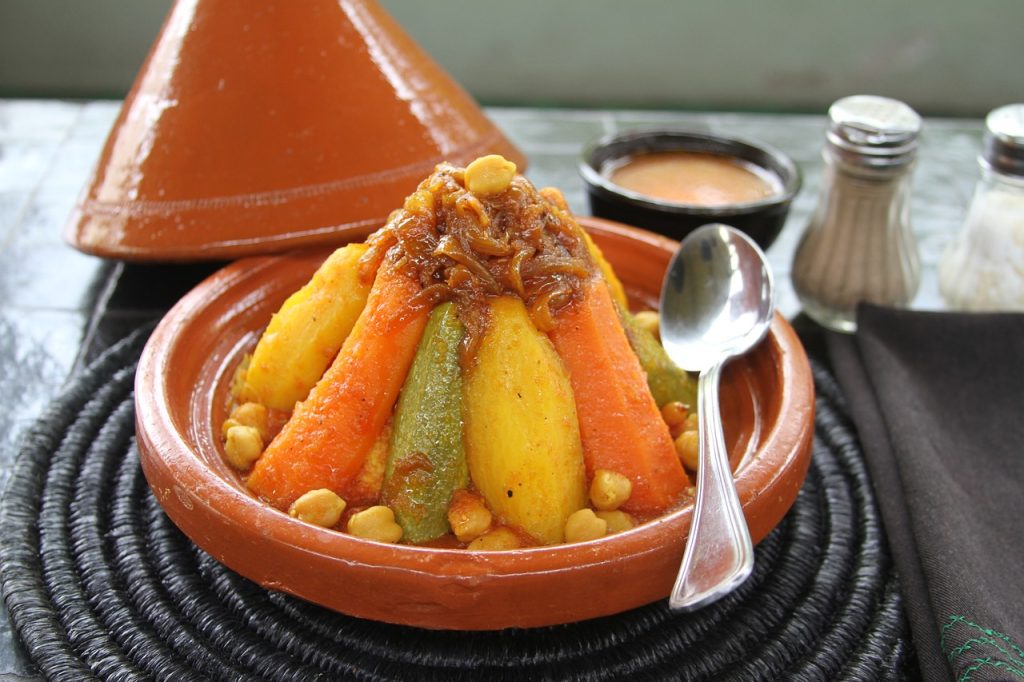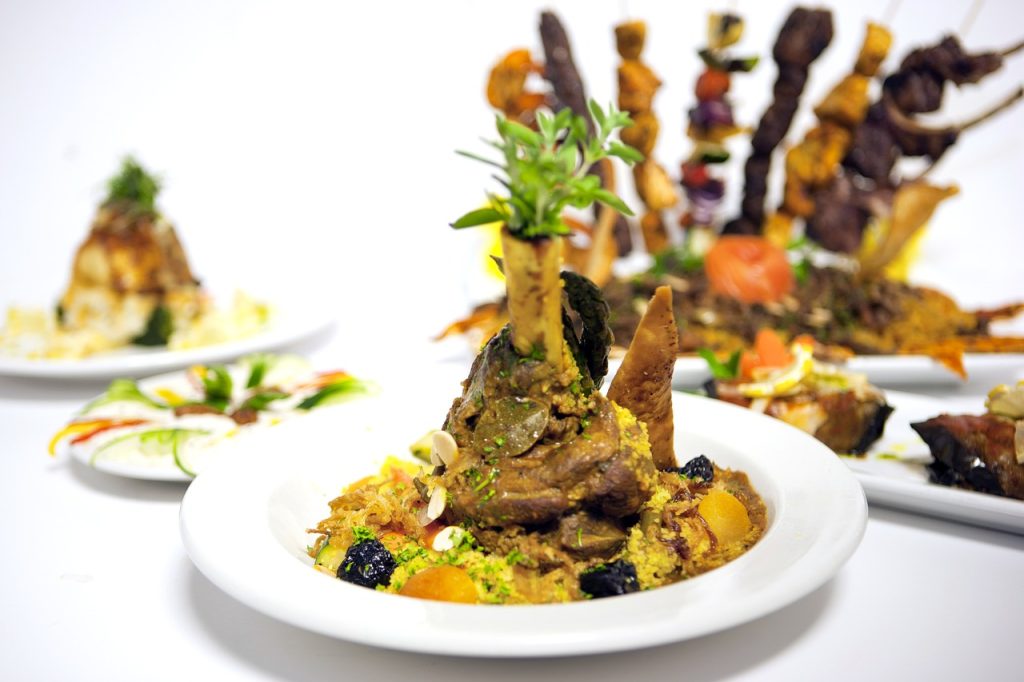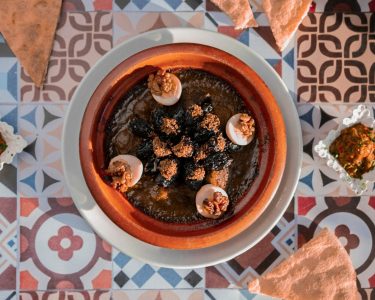If you’re planning a trip to Morocco and wondering what Moroccan food is all about, you’re not alone! Before moving to Morocco in 2023 and meeting my Moroccan partner, I had no idea what authentic Moroccan cuisine was like. In fact, I’d never even set foot in a Moroccan restaurant. Moroccan food is not as popular in places like NYC as other Mediterranean or Middle Eastern fare, such as falafel, hummus, or shawarma.

After living in Morocco for a while, I quickly learned that those dishes aren’t part of Morocco’s culinary identity. Instead, the country is known for its rich flavors and distinctive dishes like tajine, couscous, harira, mssemen, and harcha. Whether you’re a foodie or just curious about what to eat in Morocco, this guide will help you navigate Moroccan cuisine and ensure you don’t miss out on the best traditional dishes the country has to offer.
Note: Moroccan cuisine is highly accommodating for vegetarians and vegans, but if you have a nut allergy or are gluten-free, you’ll need to take extra precautions.
- Tajine: The Iconic Moroccan Dish (GF/V/Veg)
If you only try one dish in Morocco, make sure it’s a tajine. This famous dish is named after the ceramic pot it’s cooked in, featuring a conical lid that helps steam the ingredients inside. Tajines are incredibly versatile and can be adapted for different tastes, making them a great option for vegetarians, vegans, and gluten-free diets.
The flavor profile of a tajine comes from spices like cumin, coriander, saffron, and cinnamon. The dish is slow-cooked with ingredients like meat, fish, vegetables, dried fruits, olives, lemons, and apricots. Tajines can be found in almost every restaurant across Morocco, with popular varieties including:
- Lamb Tajine with Prunes
- Chicken Tajine with Preserved Lemons and Olives
- Vegetarian Tajine
Each tajine is unique, and no two taste exactly alike due to the individual touches each cook adds. While you’re likely to be served a tajine boiling hot, it’s best to wait a few minutes before digging in to avoid burning your mouth. Don’t be surprised if you’re encouraged to eat with your hands, using bread as a utensil, but cutlery is always available.
- Couscous: A Friday Tradition (Veg/V)
Couscous is another hallmark of Moroccan cuisine and is traditionally served on Fridays after the mid-day prayer. Moroccan couscous is made from steamed semolina wheat and is often paired with a savory stew made of vegetables, meat, and aromatic spices like cumin, coriander, and saffron.
Vegetarian couscous is particularly popular and is topped with an assortment of vegetables and chickpeas. Don’t forget to pour the side of broth over your couscous for added flavor!
While couscous is widely available in restaurants, for a truly authentic experience, try home-cooked couscous or attend a cooking class in cities like Essaouira to learn how to make it yourself. Homemade couscous is light and fluffy, a world away from the often disappointing versions served in some restaurants.

Note: Couscous is made with semolina, so it’s not gluten-free. However, some restaurants can prepare gluten-free couscous with rice upon request.
- Loubia: The Hearty White Bean Stew (GF/V/Veg)
Loubia is a simple yet delicious Moroccan white bean stew flavored with garlic, cumin, paprika, olive oil, tomatoes, and onions. It’s often made with lamb or beef, but vegetarian versions are also common. This dish is usually served with crusty bread and makes for a comforting meal, especially in the cooler months.
Loubia isn’t easy to find in restaurants, as it’s more of a home-cooked dish, so consider joining a cooking class if you want to experience this Moroccan staple.
- Harira: The Classic Soup of Ramadan (Veg/V)
Harira is a popular Moroccan soup, especially during Ramadan. It’s a hearty mix of tomatoes, lentils, chickpeas, and spices, often served with dates and chebakia (a sesame honey pastry) during the breaking of the fast. You can find this soup year-round, and it’s particularly warming and nourishing after a long day of exploring.
- Bissara: Fava Bean Soup (GF/V/Veg)
Bissara is a traditional Moroccan soup made from pureed fava beans, olive oil, and spices like cumin, garlic, and paprika. It’s commonly eaten for breakfast, especially in the cooler regions of Morocco. While it’s not as famous as tajine or couscous, Bissara is a favorite among locals for its simplicity and rich flavor. Try it at a local café or breakfast joint, but be sure to ask for minimal olive oil if you prefer a lighter version.
- Mssemen: Moroccan Flatbread (Veg)
Mssemen is a layered Moroccan flatbread that is often served for breakfast or as a snack. It’s crispy on the outside, soft on the inside, and is usually eaten with honey or jam. You can also find savory versions of Mssemen stuffed with onions, herbs, or ground meat.
- Harcha: Semolina Flatbread (GF/V)
Harcha is a traditional Moroccan semolina bread with a slightly crunchy exterior and a soft interior. It’s usually eaten with butter and honey and makes for a perfect breakfast or tea-time snack. Because it’s made from semolina, it’s naturally gluten-free, making it a good option for those with dietary restrictions.
- Raib: Moroccan Yogurt (GF/V)
Raib is Morocco’s version of homemade yogurt, typically enjoyed as a light dessert or snack. It’s often flavored with a touch of sugar and orange blossom water, giving it a slightly sweet, aromatic taste. It’s perfect for cooling down after a rich meal or enjoying as a simple snack between meals.
- Mint Tea: The National Drink of Morocco (V)
No trip to Morocco is complete without experiencing mint tea, also known as “Moroccan whiskey.” This tea is made from green tea, fresh mint leaves, and plenty of sugar. In northern Morocco, it’s served in tall glasses, while in the south, it comes in small teapots with the mint and sugar served on the side.
Mint tea is an integral part of Moroccan hospitality, and you’ll likely be offered a glass wherever you go. The tea is more than just a drink—it’s a symbol of warmth, friendship, and the welcoming nature of Moroccan culture.
- Amlou: Almond and Argan Oil Spread (GF/V/Veg)
Amlou is a traditional Moroccan spread made from roasted almonds, argan oil, and honey. It’s often eaten with bread for breakfast or as a snack and is considered a Moroccan version of peanut butter. Amlou is rich, nutty, and slightly sweet, making it a must-try when you’re in Morocco. However, if you have a nut allergy, be cautious, as Amlou contains almonds and is widely used in Moroccan cuisine.
- Seffa: Sweet and Savory Couscous (GF/Veg)
For something different, try Seffa, a Moroccan dish that combines couscous (or vermicelli) with cinnamon, powdered sugar, and almonds. It’s served as a dessert or a main course, and the combination of sweet and savory flavors makes it unique to Moroccan cuisine.

- Kefta: Moroccan Spiced Meatballs (GF)
Kefta refers to spiced ground meat, typically beef or lamb, shaped into meatballs or patties. These are often grilled or cooked in a tomato-based sauce and served with bread or couscous. Kefta is popular throughout Morocco and can be found in both street food stalls and restaurants.
Final Thoughts on Moroccan Food
Morocco’s cuisine is a feast for the senses, blending sweet and savory flavors with a variety of spices and fresh ingredients. Whether you’re a vegetarian, vegan, or gluten-free, you’ll find plenty of delicious options to satisfy your palate. From the iconic tajine and couscous to lesser-known dishes like loubia and bissara, Moroccan food offers a taste of the country’s rich culture and history.
Pro Tip: If you have food allergies, particularly to nuts or gluten, it’s a good idea to bring an allergy card translated into Darija (Moroccan Arabic) or French, as cross-contamination can happen, especially with nuts like almonds, which are common in Moroccan dishes.
Source : 1

